This article was co-authored by Neal Blitz, DPM, FACFAS. Dr. Neal Blitz is a Podiatrist and Foot & Ankle Surgeon who runs private practices in New York City and in Beverly Hills, California. Dr. Blitz is “The Bunion King®” and is the creator of the Bunionplasty® Procedure (plastic surgery for bunions) which has revolutionized bunion surgery. He has over 17 years of podiatric experience and specializes in minimally invasive foot and ankle surgery. Dr. Blitz received his DPM from the New York College of Podiatric Medicine, then completed a residency focused on Elective & Reconstructive Foot & Ankle Surgery at the Swedish Medical Center, and was awarded an AO Trauma fellowship in Dresden, Germany, focused on trauma and reconstructive techniques. He is board certified in Foot Surgery and Reconstructive Rearfoot & Ankle Surgery and is also a Diplomate of the American Board of Foot & Ankle Surgery and a fellow of the American College of Foot & Ankle Surgeons (FACFAS).
There are 9 references cited in this article, which can be found at the bottom of the page.
This article has been viewed 14,621 times.
Ouch! Foot pain is the worst. Unlike say a finger or a hand injury, with foot pain you still have to keep walking around and using your foot as you go about your day. If you have pain on top of your foot, like from a foot injury or tendonitis in the foot, that can be especially bothersome. Fortunately, there are things you can do to treat pain on top of your foot so you start feeling better.
Steps
How do you stretch the top of your foot?
-
1Try a toe flexion stretch. Take a seat in a chair and place the foot you want to stretch across your other knee. Grip your heel with 1 hand to brace your foot, then slowly push your big toe down with your other hand until you feel a stretch along the top of your foot. Hold the stretch for about 15-30 seconds and then release it. You can repeat the exercise 2-4 times to get a good stretch.[1]
-
2Do a standing foot stretch. Stand holding onto a wall or counter to help yourself balance. Curl the toes of the foot you want to stretch and place the top of your foot on the floor. Slowly bend your knee and lean forward until you feel a stretch on the top of your foot. Hold the stretch for 3-5 seconds and repeat the motion 10-25 times.[2]
How can you tell if you broke the top of your foot?
-
1There’s swelling, bruising, or tenderness on the top of your foot. If you broke the top of your foot, your symptoms can vary slightly depending on how severe the damage is. Generally, you’ll have some swelling and bruising on the top of your foot. The area will also be super tender and may hurt more whenever you try to walk on it. If you think you broke your foot, go to a hospital for treatment.[4]
-
2There’s immediate, throbbing pain and your foot looks deformed. A serious broken bone, also known as a fracture, may cause the top of your foot to look deformed or like there’s a bump beneath the skin. You’ll also likely experience super intense pain that feels like your foot is throbbing and prevents you from putting any weight on it. Get to a doctor as soon as possible for medical treatment.[5]
When should you go to the doctor for pain on top of your foot?
-
1You have severe pain or swelling. Severe pain and swelling is a sign of a possible fracture or serious foot injury. Go to a doctor as soon as you can to have your foot examined to find out what the issue is. Your doctor will be able to prescribe medications and recommend treatments that can help you deal with your foot pain.[6]
-
2You have an open wound or an infection. If you have an open sore or wound that won’t heal properly, it could be a sign of a serious injury or an underlying medical condition. Additionally, if there’s redness, oozing pus, or you have a fever over 100 F (37.8 C), it could be a sign of infection, which needs prompt medical attention. Seriously, infections aren’t anything to play around with. They could lead to other serious problems, so get to a doctor quickly.[7]
-
3You’re unable to walk or put any weight on your foot. Difficulty walking or standing on your foot could be a sign of an underlying medical condition or a hidden injury. Even if your foot looks fine or you don’t recall hurting it, if you can’t walk on it, you need to go see a doctor. They’ll be able to examine it and run tests to find out what the problem is.[8]
Expert Q&A
Did you know you can get expert answers for this article?
Unlock expert answers by supporting wikiHow
-
QuestionWhat's an easy way to stretch my foot?
 Neal Blitz, DPM, FACFASDr. Neal Blitz is a Podiatrist and Foot & Ankle Surgeon who runs private practices in New York City and in Beverly Hills, California. Dr. Blitz is “The Bunion King®” and is the creator of the Bunionplasty® Procedure (plastic surgery for bunions) which has revolutionized bunion surgery. He has over 17 years of podiatric experience and specializes in minimally invasive foot and ankle surgery. Dr. Blitz received his DPM from the New York College of Podiatric Medicine, then completed a residency focused on Elective & Reconstructive Foot & Ankle Surgery at the Swedish Medical Center, and was awarded an AO Trauma fellowship in Dresden, Germany, focused on trauma and reconstructive techniques. He is board certified in Foot Surgery and Reconstructive Rearfoot & Ankle Surgery and is also a Diplomate of the American Board of Foot & Ankle Surgery and a fellow of the American College of Foot & Ankle Surgeons (FACFAS).
Neal Blitz, DPM, FACFASDr. Neal Blitz is a Podiatrist and Foot & Ankle Surgeon who runs private practices in New York City and in Beverly Hills, California. Dr. Blitz is “The Bunion King®” and is the creator of the Bunionplasty® Procedure (plastic surgery for bunions) which has revolutionized bunion surgery. He has over 17 years of podiatric experience and specializes in minimally invasive foot and ankle surgery. Dr. Blitz received his DPM from the New York College of Podiatric Medicine, then completed a residency focused on Elective & Reconstructive Foot & Ankle Surgery at the Swedish Medical Center, and was awarded an AO Trauma fellowship in Dresden, Germany, focused on trauma and reconstructive techniques. He is board certified in Foot Surgery and Reconstructive Rearfoot & Ankle Surgery and is also a Diplomate of the American Board of Foot & Ankle Surgery and a fellow of the American College of Foot & Ankle Surgeons (FACFAS).
Board Certified Podiatrist
-
QuestionHow can I tell for sure if my foot is fractured?
 Neal Blitz, DPM, FACFASDr. Neal Blitz is a Podiatrist and Foot & Ankle Surgeon who runs private practices in New York City and in Beverly Hills, California. Dr. Blitz is “The Bunion King®” and is the creator of the Bunionplasty® Procedure (plastic surgery for bunions) which has revolutionized bunion surgery. He has over 17 years of podiatric experience and specializes in minimally invasive foot and ankle surgery. Dr. Blitz received his DPM from the New York College of Podiatric Medicine, then completed a residency focused on Elective & Reconstructive Foot & Ankle Surgery at the Swedish Medical Center, and was awarded an AO Trauma fellowship in Dresden, Germany, focused on trauma and reconstructive techniques. He is board certified in Foot Surgery and Reconstructive Rearfoot & Ankle Surgery and is also a Diplomate of the American Board of Foot & Ankle Surgery and a fellow of the American College of Foot & Ankle Surgeons (FACFAS).
Neal Blitz, DPM, FACFASDr. Neal Blitz is a Podiatrist and Foot & Ankle Surgeon who runs private practices in New York City and in Beverly Hills, California. Dr. Blitz is “The Bunion King®” and is the creator of the Bunionplasty® Procedure (plastic surgery for bunions) which has revolutionized bunion surgery. He has over 17 years of podiatric experience and specializes in minimally invasive foot and ankle surgery. Dr. Blitz received his DPM from the New York College of Podiatric Medicine, then completed a residency focused on Elective & Reconstructive Foot & Ankle Surgery at the Swedish Medical Center, and was awarded an AO Trauma fellowship in Dresden, Germany, focused on trauma and reconstructive techniques. He is board certified in Foot Surgery and Reconstructive Rearfoot & Ankle Surgery and is also a Diplomate of the American Board of Foot & Ankle Surgery and a fellow of the American College of Foot & Ankle Surgeons (FACFAS).
Board Certified Podiatrist
-
QuestionWhat is a stress fracture?
 Neal Blitz, DPM, FACFASDr. Neal Blitz is a Podiatrist and Foot & Ankle Surgeon who runs private practices in New York City and in Beverly Hills, California. Dr. Blitz is “The Bunion King®” and is the creator of the Bunionplasty® Procedure (plastic surgery for bunions) which has revolutionized bunion surgery. He has over 17 years of podiatric experience and specializes in minimally invasive foot and ankle surgery. Dr. Blitz received his DPM from the New York College of Podiatric Medicine, then completed a residency focused on Elective & Reconstructive Foot & Ankle Surgery at the Swedish Medical Center, and was awarded an AO Trauma fellowship in Dresden, Germany, focused on trauma and reconstructive techniques. He is board certified in Foot Surgery and Reconstructive Rearfoot & Ankle Surgery and is also a Diplomate of the American Board of Foot & Ankle Surgery and a fellow of the American College of Foot & Ankle Surgeons (FACFAS).
Neal Blitz, DPM, FACFASDr. Neal Blitz is a Podiatrist and Foot & Ankle Surgeon who runs private practices in New York City and in Beverly Hills, California. Dr. Blitz is “The Bunion King®” and is the creator of the Bunionplasty® Procedure (plastic surgery for bunions) which has revolutionized bunion surgery. He has over 17 years of podiatric experience and specializes in minimally invasive foot and ankle surgery. Dr. Blitz received his DPM from the New York College of Podiatric Medicine, then completed a residency focused on Elective & Reconstructive Foot & Ankle Surgery at the Swedish Medical Center, and was awarded an AO Trauma fellowship in Dresden, Germany, focused on trauma and reconstructive techniques. He is board certified in Foot Surgery and Reconstructive Rearfoot & Ankle Surgery and is also a Diplomate of the American Board of Foot & Ankle Surgery and a fellow of the American College of Foot & Ankle Surgeons (FACFAS).
Board Certified Podiatrist
Warnings
- Don’t take any medications to treat your foot pain without first talking to your doctor to make sure they’re safe for you.⧼thumbs_response⧽
References
- ↑ https://myhealth.alberta.ca/Health/aftercareinformation/pages/conditions.aspx?hwid=bo1628
- ↑ https://www.health.harvard.edu/staying-healthy/exercises-and-stretches-for-foot-health
- ↑ https://medlineplus.gov/ency/patientinstructions/000652.htm
- ↑ https://patient.info/foot-care/heel-and-foot-pain-plantar-fasciitis/metatarsal-fractures
- ↑ https://patient.info/foot-care/heel-and-foot-pain-plantar-fasciitis/metatarsal-fractures
- ↑ https://medlineplus.gov/ency/patientinstructions/000571.htm
- ↑ https://www.mayoclinic.org/symptoms/foot-pain/basics/when-to-see-doctor/sym-20050792
- ↑ https://www.nhs.uk/conditions/foot-pain/pain-in-the-top-of-the-foot/
- ↑ https://www.nhs.uk/conditions/foot-pain/pain-in-the-top-of-the-foot/
- ↑ https://www.aafp.org/afp/2009/1115/p1107.html
- ↑ Neal Blitz, DPM, FACFAS. Board Certified Podiatrist. Expert Interview. 22 April 2020.
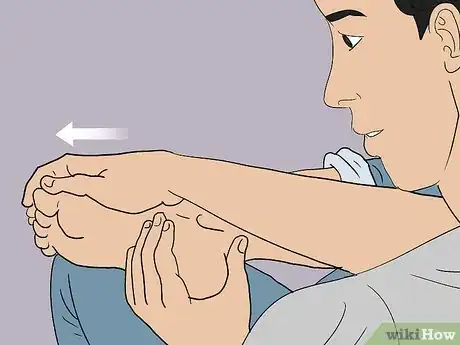

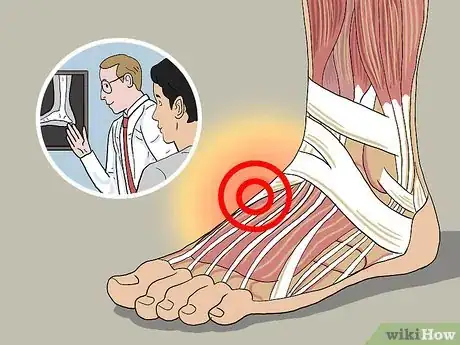
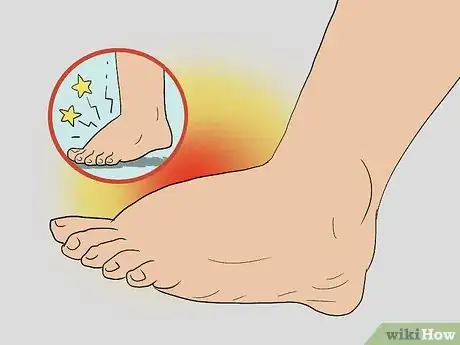
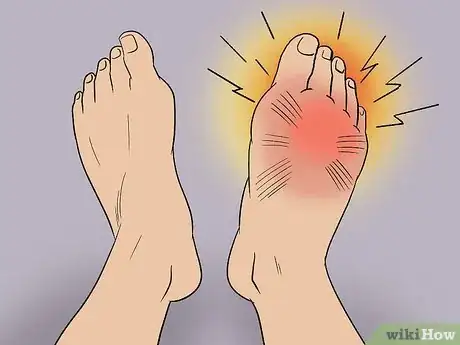


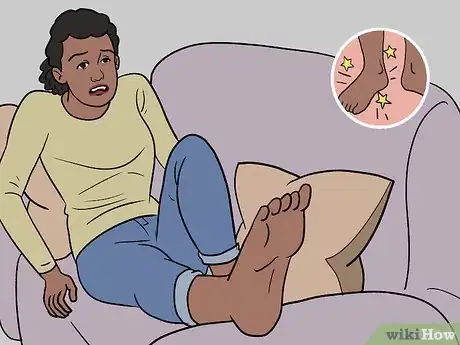

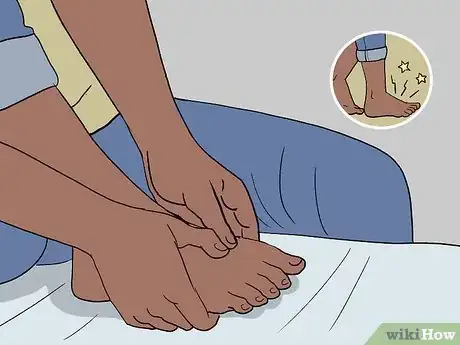




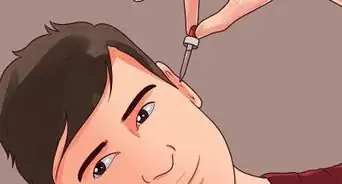







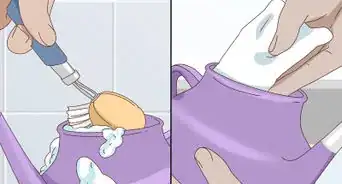














































Medical Disclaimer
The content of this article is not intended to be a substitute for professional medical advice, examination, diagnosis, or treatment. You should always contact your doctor or other qualified healthcare professional before starting, changing, or stopping any kind of health treatment.
Read More...